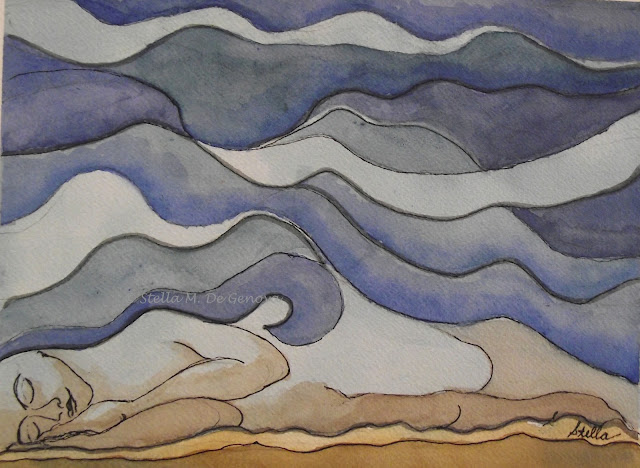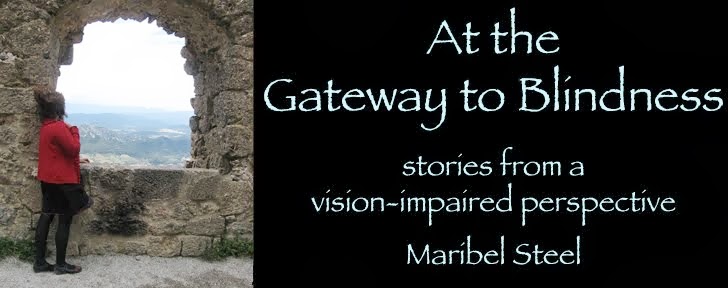‘Art is a personal apperception, which I embody in sensations
and which I ask the understanding to organize into a painting.’
Paul Cèzanne
and which I ask the understanding to organize into a painting.’
Paul Cèzanne
I once asked a blind scientist in an interview, curious to hear his attitude towards colour, what comes to his mind if I tell him that the juice in his glass is orange?
When he answered, ‘I have no emotional attachment to colour’, I found this reasonable response confronting. Even with the tiniest glimpse of colour I may see in a bright light, I realised in that split second how attached to colour I am. I may be labelled ‘legally blind’ but my brain and eyes are always seeking out colour and shape – for as long as there are some shades in the colour spectrum to discern, my brain will offer logical deductions to help make sense of the blurry world all around.
Our eyes don't send images to our brain, but rather, images are constructed in the brain based on the simple signals sent from our eyes.
The moment I leave the front door and step into the world of the sighted, the two words that pop up every five seconds accompanying the rhythmic tap-tap of the cane are, what’s that...what’s that...what’s that?
My eyes and brain demand an answer and when no helpful image appears in my mind’s eye, my hands will reach out and touch the ‘what’s that’ and we are all happy again – for a five second interlude. But when the object is too far away or impossible to see because of faulty light- sensitive cells at the back of my scarred retinas, my brain asks: ‘Eyes, please be more specific, I have no idea what that is!’
Pattern Recognition
“Our brains form images based on pattern recognition. We don't see images; our eyes see line and motion, our brains interpret that to attempt to recognize to what sort of thing those lines and motion might represent, and then our brains seamlessly cause us to perceive whatever that object might be.” (Ken Rockwell)
During the day, most things appear in my view as a light something or other, or a dark something else. That’s it – light... or dark? With the curiosity of a child, in a constant state of visual training, nagging thoughts demand to know more than this because blindness is not bliss.
So the light blob or dark blob gets my brain thinking, which offers an internal dialog – “OK, something dark up ahead...near the corner of a side street...doesn’t look like a shrub...or a person...could be red in colour...has a curved top...” I get a little closer...give it a tap at the base with my cane... “Oh, it’s an Australia Post box.”
The guessing game continues like this for the entire time I’m away from home –concentrated analysis between brain and eyes to help discern the environment at every step of the way. As seeing colours does not come naturally, then I ask myself, maybe I am only SEEING through the eyes of logic and not seeing colour at all? Is my view of the world a collection of childhood memories – millions of images stored in my mind’s eye?
The Power of Persuasion
I notice the power of persuasion by the brain to dominate colours when I am shopping for clothes. As I take a piece of clothing from the rack to bring the most direct light onto the garment, my eyes can think ‘This looks orange.’ But when I confirm the colour with the shop assistant, they can say, ‘It’s green.’ And THEN I can see it as green.
This happens all the time. Blue can be interpreted as purple, yellow can be grey, red can be brown, pink can even be pale green. So once the garment is purchased, brain makes a note to remember its shade for the next time I want to wear it.
About 8% of men and 1% of women have some form of colour impairment but I am not colour blind, it is my damaged little retinas struggling to see clearly.
When I do see, I stop to drink in the scene – the cornflower blue of a summer’s sky, the bold yellow petals of a dazzling sunflower, the deep red of a freshly picked tulip, the creamy white flesh of a homegrown apple, the purple sparkle of an amethyst crystal, the hot pink and white stripes on my grand-daughter’s dress – when I truly see these things, my heart feels as if I am the luckiest person alive!
Why would I care so deeply about seeing colour, isn’t the memory of colour enough? But as with the delicate scent of a rose, I can hold fond memories of its sweet fragrance but it is only when I smell it again, that it triggers the memory.
So it is for me with colour: I am still a visual person at heart and even as sight fades, my brain will have to work a little harder and keep pestering my ailing eyes to ‘Please be more specific...’
“Mere colour, unspoiled by meaning, and unallied with definite form,
can speak to the soul in a thousand different ways.”
Oscar Wilde
can speak to the soul in a thousand different ways.”
Oscar Wilde
What’s it like to be a visually impaired artist whose color differentiation is fading?
Here is a piece written by Stella De Genova, a friend in the USA, who has not let her vision-impairment diminish her love and joy of painting. I admire her enthusiasm as she experiments with her visual interpretations of colour and shape through concepts and feelings.
“Frustrating may be the first word that comes to mind but I’m not going to be that hard on myself. I take this as a new opportunity to break the rules and color outside of the lines.
Depending on the time of day or lighting, colors change and may or may not be so apparent. And that’s for people with good vision. If you look at something long enough, you’ll see, more than one color in just about anything. And you can paint white snow or a white vase without even using white paint.
So try as I may, I don’t always get it right, which is OK because it makes for new interpretations of everyday life. It makes me smile when the art instructor critiques my piece and says, “Green usually works better in skin tones than blue but that really worked for you.” Little does she know that I thought I did use green!
Of course, if I start out really wanting something to be accurate, I’ll ask someone for the correct colors but as the picture takes its own shape and I keep adding new layers, the colors tend to change.
Yes, when this new aspect of my vision loss started, it was frustrating but I’m learning to be less of a perfectionist and, ultimately, that means I have the freedom to have more fun.
Stella M. De Genova was born and raised in Chicago, Illinois. She is a visually-impaired artist who has had RP from childhood. Her impairment takes her on a continuous journey with life and her artwork. Her favourite pieces are those that have taken on a life of their own. Rather than trying to replicate the style of a fully-sighted artist, Stella uses her visual impairment as another tool for creativity and discovery, resulting in her own unique style.
To view or purchase Stella’s artwork visit:
http://artbystelladg.com/
http://artbystelladg.com/
 |
| Dream Under a Desert Sky |
Next post: Insight through sound
© 2013 Maribel Steel





